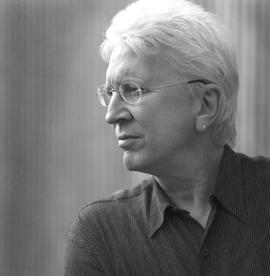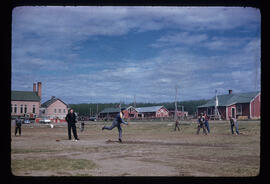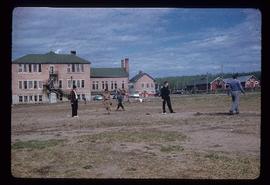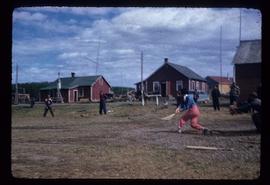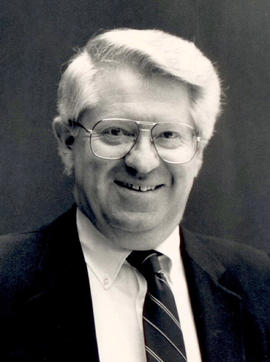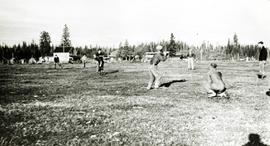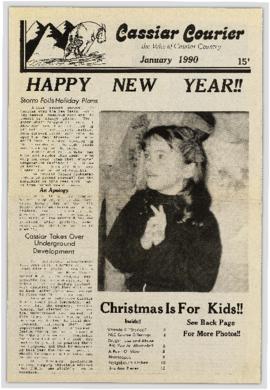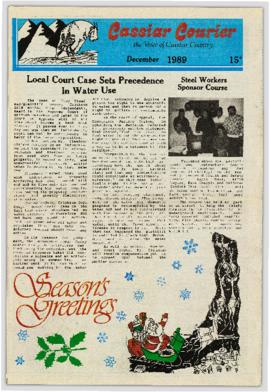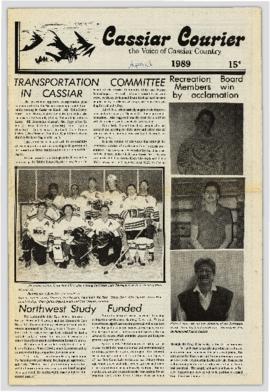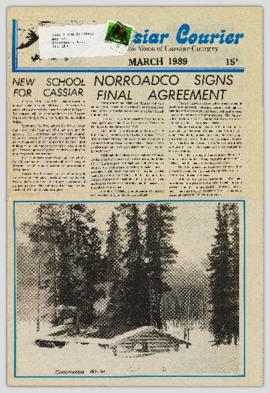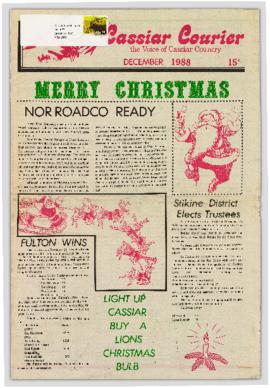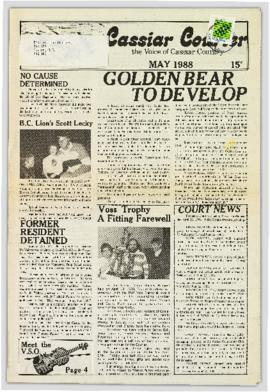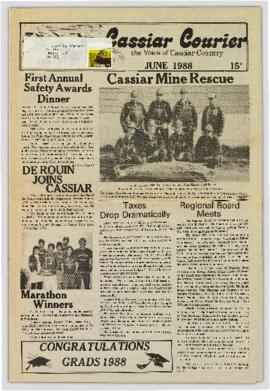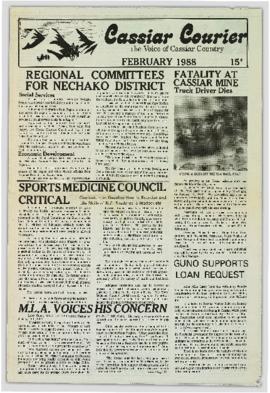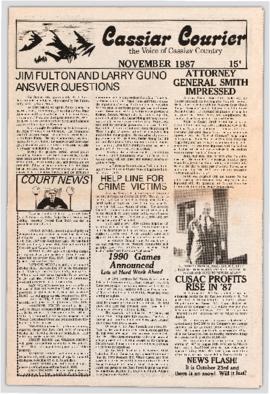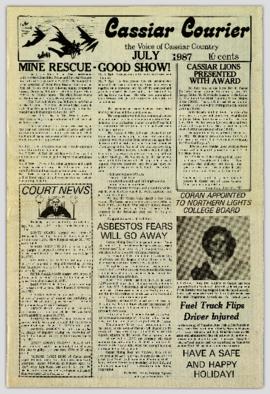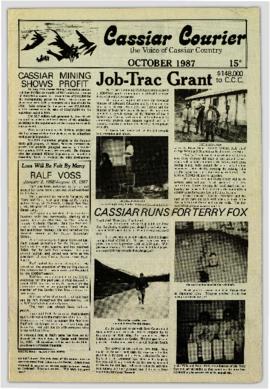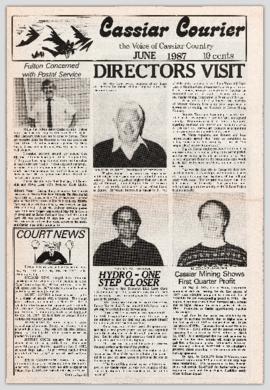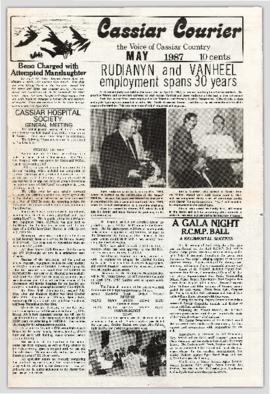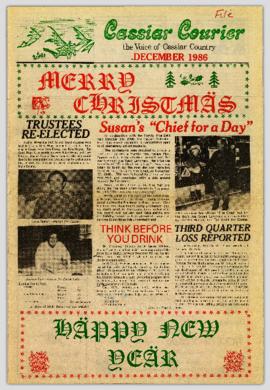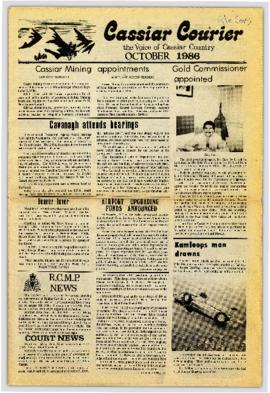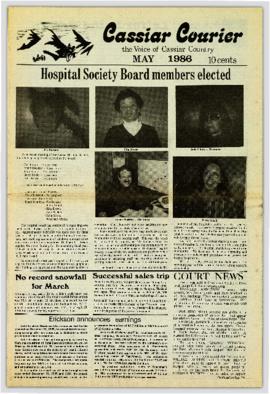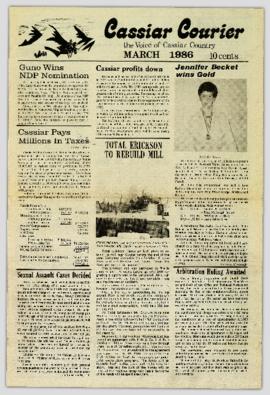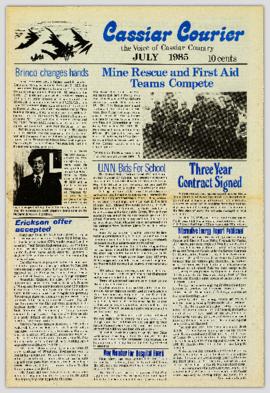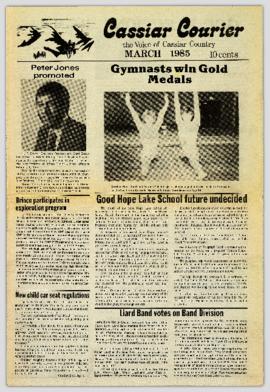Fonds consists of personal papers, books, manuscripts, photographic materials, audio recordings and electronic records arranged into five series, which relate to Mr. Fawcett's personal life, his creative works and his relationships with members of the literary community.
Fawcett, BrianThis document is an unpublished draft manuscript of a Northern British Columbia history annotated bibliography. The document is based overwhelmingly on research into secondary sources published prior to 2016; more recent sources are not included. The annotated bibliography includes the following sections:
- Historiography
- Settlement Histories
- Alexander Begg's History of British Columbia
- R.E. Gosnell
- E.O.S. Scholefield
- Regional History
- New Histories
- Environment
- Northern History
- Ancient History
- Bibliography
Photograph depicts unidentified men standing in baseball field, large buildings visible in background. Handwritten annotation on recto of mounted slide reads: "Base ball in Lejac". See also items 2006.20.1.200 - 2006.20.1.202 for images featuring similar content.
Photograph depicts baseball game, batter in mid-swing,and buildings visible in background. Handwritten annotation on recto of mounted slide reads: "Base ball game in Lejac". See also items 2006.20.1.199 - 2006.20.1.202 for images featuring similar content.
File consists of notes, clippings, and reproductions relating to the Cariboo and Northwest Digest publication. Also includes a CD-R that contains Sedgwick's index spreadsheet and accompanying documentation about the publication.
The photograph depicts Mark Gabriel Stadium, a baseball stadium in Prince George. The photo was taken in 2005.
The photograph depicts Mark Gabriel Stadium, a baseball stadium in Prince George. The photo was taken in 2005.
This fonds illustrates the life and work of G. Gary Runka and his contributions to the province of British Columbia. Gary Runka was the first General Manager of British Columbia's Agricultural Land Commission and helped establish the provincial Agricultural Land Reserve. After transitioning from a government career to private consulting, Runka provided comprehensive professional services through his land consultancy business, G.G. Runka Land Sense Ltd., offering land capability and environmental assessments, integrated resource management, land and water use conflict resolution, and interdisciplinary land use planning. Described by colleagues as one of BC's most highly respected agrologists and influential land use planners, Runka had a 52-year career working on (or against) an incredible number of landmark projects in British Columbia, such as the Site C Project. Gary Runka’s partner in life and vocation, Joan M. Sawicki, worked with Gary on many of these projects—as well as her own; her contributions are also represented throughout the records of this fonds.
Gary Runka's deep connection to the land is evident from his earliest papers on aerial photo interpretation, his work with the Canada Land Inventory, through his speeches and his work establishing the BC Agricultural Land Reserve and in his subsequent consulting career through G.G. Runka Land Sense Ltd. Gary Runka's influence and legacy was recognized in the tributes paid after his death, including the post-humus award as the Real Estate Foundation's "Land Champion" for 2014.
The G. Gary Runka fonds has been divided into the following nine series:
1) Personal Records
2) Speeches & Publications
3) Professional Records
4) Agricultural Land Commission
5) Land Sense Ltd.
6) Client Files
7) Maps
8) Photographs
9) Digital Records
Subseries consists of material collected and created by Kent Sedgwick for research relating to community life in Prince George. The files primarily consist of notes and newspaper clippings discussing life in Prince George during the 20th century. Subseries contains material on public services and infrastructure including fire protection, electricity, water towers, policing and jails, and medicine; the history of businesses including Northern Hardware; public events; and recreational activities including hockey, baseball, curling, skiing, tennis, soccer, lacrosse, boxing, horse racing, golfing, and art.
File consists of clippings, notes, and reproductions relating to sports in Prince George, such as hockey, baseball, curling, skiing, tennis, soccer, lacrosse, boxing, horse racing. File predominantly includes clipped articles relating to development of parks and stadiums to hold sporting events. Includes various photocopied articles from the Prince George Citizen newspaper; "Gyro summary" printed email from Valerie Giles to Kent Sedgwick (14 July 2009); "RE: Commercial centre name" printed email chain between Kent Sedgwick and Rupinder Basi (7 Mar. 2007); and "Bylaw amendment #5909" letter to the mayor from Kent Sedgwick (20 Sept. 1993). Also includes photographs taken in 2005 of the Mark Gabriel stadium.
Drawing of proposed Pacific Rim Stadium on False Creek in Vancouver. The drawing shows details of the baseball configuration, football configuration, and a perspective sketch of the stadium adjacent to the Georgia Viaduct. Annotated sketch of light rail transit route is also depicted.
File consists of speeches, correspondence, itineraries, ephemera, agendas, and reports relating to Campagnolo's political speeches of 1978. Includes:
- Blank certificate: “Special Ministerial Certificate of Commendation Presented to…in Recognition of Outstanding Commitment to Physical Fitness and Healthful Lifestyle by…Iona Campagnolo, Minister of State Fitness and Amateur Sport…Awarded this…day of…”
- Undated, handwritten, itinerary for Friday 16th and Saturday 17th
- Tickets to various events at the XI Commonwealth Games in Edmonton, August 1978
- Telex from Havana, Cuba to Iona Campagnolo re: joint communiqué signed by Minister Iona Campagnolo and Jorge Garcia Bango, President of the National Institute of Sports, Physical Education and Recreation of Cuba, January 10, 1978
- Notecard to Iona Campagnolo from Jorge Garcia Bango, President of the National Institute of Sports, Physical Education and Recreation of Cuba, 1978
- Letter to Iona Campagnolo from Eric Morse, Department of External Affairs, re: thank you for present, January 11, 1978
- Letter to Iona Campagnolo from Alan (?) re: thanks, December 17, 1978
- Telex to Iona Campagnolo from Ian S. Ross, Swan Wooster Engineering, re: thanks for help with Cuba, December 21, 1978
- Notecard to Iona Campagnolo from Alan Wright re: congratulations, September 19, 1978
- Telex to Iona Campagnolo re: Nigerian participation in Commonwealth Games, July 26, 1978
- Letter to Iona Campagnolo from Derek Holmes re: Hockey Canada event
- Handwritten speech by Iona Campagnolo welcoming visitors to the BC Northern Winter Games in Prince George, 1978
- Speeches (?) made in honour of Hon. Jack Horner, Smithers, May 6-7, 1978
- Program for The Parliamentary Press Gallery Annual Dinner and Revue, March 18, 1978
- Page 6273-6274 of Commons Debates, June 12, 1978 featuring Iona Campagnolo discussing Loto Canada
- Telex to Iona Campagnolo from unidentified re: birthday wishes, October 19 (ca. 1978)
- Letter to Iona Campagnolo from Mitchell Sharp, Northern Pipeline Commissioner re: thank you, May 4, 1978
- Itinerary for Iona Campagnolo trip: Terrace to Vancouver, September 1-10, 1978
- Memo from Tom McIllfaterick to Art Lee / David McPhee re: rescheduling of Caucus / Candidate meeting in Vancouver based on enclosed itinerary, June 5, 1978
- Copy of the Sunday Sun newspaper* vol.1, no.113, August 13, 1978 featuring front page heading: “What a way to go” re: the 1978 Commonwealth Games in Edmonton, Alta. (SEPARATED SEE “OVERSIZE BOX #35”)
- Copy of Catch, newsletter of Canadian Amateur Rowing Association, March/April 1978 featuring Iona Campagnolo on front cover
- Speech by Iona Campagnolo to the 2nd Canadian Congress on Leisure Research, Toronto, April 27, 1978
- Notecard to Iona Campagnolo from Marcel Roy, M.P. Laval, ca. 1978
- Handwritten letter to Iona Campagnolo from Faetana (?) of the Embassy of the United States of America, re: thank you & praise, July 3, 1978
- Letter to Members of the Board of Hockey Canada from R. Alan Eagleson re: “Brief to the Board of Hockey Canada” presented by Douglas Fisher, September 25, 1978
- Letter to Iona Campagnolo from Alan Eagleson, September 18, 1978
- Typed agenda notecard for Friday, April 21, ca. 1978
- Telex for Iona Campagnolo in Havana re: baseball diplomacy, April 24, 1978
- Letter to Iona Campagnolo from Christopher Lang re: sport in Canada, January 19, 1978
- Itinerary for March to April 1978
- Typed agenda notecard for Friday, June 3, ca. 1978
- Page 1 of Telex to Iona Campagnolo in Havana re: reunification of families, May 9, 1978
- 1978 Commonwealth Games in Edmonton – ticket brochure featuring events, times and ticket cost
- Press release: “Royal Bank, Canadian Olympic Association sign $500,000 Junior Olympic Pact”, November 1978
- Letter (in Spanish) to Cuban President Fidel Castro Ruz from Iona Campagnolo re: recent visit to Cuba, February 24, 1978
- Signed letter to Iona Campagnolo from Walter F. Mondale, Vice President of the United States re: appreciation, January 19, 1978
- Letter to Iona Campagnolo from R. Roy McMurtry, Attorney General, Ontario re: appreciation, December 14, 1978
File consists of an audio recording of an interview with Lea Gobbi and Kate Anderson. Includes two original recorded audio cassettes and two copies.
File consists of a transcript of an oral history interview with John and Bernice Trick.
This souvenir program for the New York Harlem Aces Basketball Show. Includes autographs from Rip Collins, Smokey Johnson, Marty Garrett, William "Champ" Brown, K. Scott, and others. This souvenir program may have been obtained at a show in Prince George, BC (unconfirmed).
File consists of:
- David Mills, "Aleza Lake Research Forest Historical Internship Summary" (2 Jan. 2007), 26 p. - In print and original digital .doc file
- David Mills, "Aleza Lake Forest Experiment Station Socio-Economic Time Line 1905-1937" (2007), 68 p. - In print and original digital .doc file
- ALRFS employment paperwork for David Mills, the ALRFS Natural Resource History Intern
- Research notes, including a copy of a map of the town of Aleza Lake in the 1920s
Contains significant materials covering a wide range of topics related to forestry research and forest management practices in Central British Columbia from the 1920s to the 1980s with the bulk of the materials dating from 1924 to 1963. Includes early surveys and descriptions of the Upper Fraser area, early maps and plans of the Research Forest, and historical meteorological registers from the area. Also includes unpublished scientific reports, communications, administrative and technical reports, timber sale records, and general forestry related reports and publications. Photographs include images of the Experimental Station dating from its inception and images of the Young Men's Forestry Training Program situated at Aleza Lake in 1936. Research records include experimental plot files that contain field notebooks dating from 1928 to 1958 which note locations of the experimental plots as well as sample plots from the surrounding areas of Hutton, Penny, and Foreman. The field notebooks also record growth and mortality data of white spruce balsam from 1928 to 1958 and soil types. The fonds also contains some records related to the re-emergence of the Aleza Lake Research Forest (ALRF) in the 1980s and 1990s.
Aleza Lake Research ForestFile consists of a transcript of an oral history interview with Ivan and Bev Westerland.
File consists of a transcript of an oral history interview with Carl Strom.
File consists of a transcript of an oral history interview with Glen Stanley.
File consists of a transcript of an oral history interview with Alice Sanregret.
File consists of a transcript of an oral history interview with Jean May.
File consists of a transcript of an oral history interview with Doug Homme. Also includes photocopies of Doug Homme's personal records, such as photographs.
File consists of a transcript of an oral history interview with Doug Frazier and Linda McFarlane.
File consists of a transcript of an oral history interview with Julie Fisher.
File consists of a transcript of an oral history interview with Heather (Scott) Empey.
Audio recording consists of an interview conducted by Bridget Moran with Mary John.
Audiocassette Summary
Scope and Content: Tape recording is an interview between Bridget Moran and Mary John – a continuation of interviews.
Side 1
0’02” Bridget asks Mary when she quit smoking - in 1972
1’00” Mary notes there was no talk of sex life; not part of First Nations culture
2’00” Mary talks about when she started working at the hospital; she was able to save money and her husband drove her back and forth; lived in a tent to save money; they pumped water to drink from a well 1 mile away so that they did not get sick; she notes she began working at hospital after her husband lost his seasonal job
5’00” Mary notes they had to have a tribunal hearing to get old age pension for her husband because his birth was not registered
7’00” Mary recalls that the Depression did not hit reserves as hard as white people because ‘they had always been poor’; yet at that time they were never without food. She talks about tough times during the Depression – could not find work only relief; got used clothing from white people
10’00” Mary refers to a Mrs. Campbell, a white woman who was a widow and had small children who was also poor in the Depression and showed her how to repair socks
12’00” She notes that they did not have much of a relationship with the Indian Agent – they knew he existed but they did not see him much; viewed him as a representative for the Indians; some [of the Indian Agents] were good and some were bad; she describes difficulties with the Indian Agent and getting little food: only a single ration (24 bag of flour; 5 lb bag of rice, bag of salt; ½ lb tea and 2 lbs lard) to last a family for a month and also flannelette material to make bed clothes. Indian Agent Office was in Vanderhoof
17’00” Mary recalls that the watchmen quit in the 40s – that is when marriages stopped being arranged; there were no Band Managers then; that only ‘started recently’
19’00” Mary talks about the priest who lived on the reserve in the 1940s; she does not know whether the [Catholic] Church was good for her people. Does not think that the Catholic Church was good for Indian Culture – they were the ones that ‘took it away’ […] tried to beat it out of the children
24’00” She notes that since that time she has been asked to teach dancing and classes in Indian culture; notes that some children can speak “Indian” in Mary’s family; notes her children can speak their own language
27’00” Mary talks about when the residential school Lejac closed; that it was taken over by the Department of DIA
29’00” Mary sees ‘Alcohol as the worst problem among First Nation’ – she recalls that a group of them began to get together to ‘pray and work with people who needed the most help’; she notes that while native people were not allowed to buy alcohol before and now have the right to get it - it has since become a problem; she describes the effect of alcohol on the community. She notes that although she and her husband did drink at one time she doesn’t anymore and recognized it as a problem back in the 1950s. She describes her feelings after a nephew was killed in an alcohol-related accident and how this convinced her to quit drinking; it was a choice she made on her own
40’00” Talks about early years when they were married and how difficult life was at that time; she recalls going to see the children at Lejac and camping out to visit them; she describes how to make a camp with spruce boughs and bringing food to camp
45’00” Describes the furniture and stove they had in their house when Ernie (son) was born A lot of time spent with one another for recreation
(Continuation on side B – labeled as #6)
Side 2
48’00” Mary John talks about the church priest – would not come out every Sunday for Mass – only started recently having mass frequently; talks about the hospital where nuns worked;
56’00” Bridget asks her about recreation on the reserve; Mary talks about clothing used on sports team – played Stellako and other reserves; “Baseball was popular” – hardball; she recalls going to Prince George to watch ball tournaments
60’00” Discusses recreation in early years; would have dances at people’s houses
62’00” Mary discusses white-native relations; ‘we never talked about it’ there were white people who were ‘good people’ that she did work for; cases of racial tensions in Vanderhoof
67’00” Bridget asks her if any white people ever came to visit her home; Mary notes that none came out to the reserve – the only one that use to come out was the priest and remembers the priest eating breakfast at her home. But “Prince George wasn’t like that” She tells of racist comments even now that she experienced with a new doctor in town
End of session – tape ends temporarily Start up of session again
74’00” Mary John talks about their efforts to educate and pass on their culture to younger generations; they now teach survival in the bush. She explains that this is to get native youths to experience being in the bush and teach them how to prepare food at camp; how to prepare fish and smoke fish. She talks about the location of the survival camp, close to Wedgewood; “sometimes would have close to 12 students”
End of session – tape ends temporarily Start up of session again
83’00” Mary talks about Aunt Mary Sutherland. Bridget asks about Mary’s husband [Lazare] his family history.
88’00” Bridget asks Mary about the history of Stoney Creek Reserve; Mary then proceeds to note the names of the families who lived at the reserve. She notes that she was originally born at Fort George. They talk about an Indian Agent in the 1950s and the building of houses on the reserve
92’00” Talks about family logging business
End of tape
File consists of a transcript of an oral history interview with Kate Anderson and Mae Romanin.
File consists of one 5.25" floppy disk, containing the following files:
- “Alcohol” -Transcript of Mary John discussing her history with alcoholism; how it is the biggest problem facing First Nations people
- “Changes”- Transcript of Mary John discussing the changes on the reserve, including TV, hot water, and electricity. John talks about how she earns her money through leatherwork
- “Depression”- Transcript of Mary John discussing how hard the Depression was on First Nations people. They would trade fish for clothing during that time
- “Indian Agent and Department of Indian Affairs”- Transcript of Mary John discusses the corruption of the Department of Indian Affairs and how many of the Indian agents were indifferent to First Nations people
- “Hides”- Transcript of Mary John discussing how to make proper moose hides
- “Lejac”- Short paragraph on the residential school of Lejac
- “Marriage”- Transcript of Mary John discussing how finances were poor because of the Depression. She discusses how her husband made railway ties to earn money
- “Mike”- A birthday letter to Mike, Bridget Moran’s son, expressing her joy of having a computer
- “Net Fishing”- Transcript of how to set fishing nets in the water
- “Potlatch”- Transcript of what a potlatch is, how many clans there are and what they mean
- “Siblings”- Transcript of Mary John discussing her stepbrothers and sisters. She talks of Mark, her oldest brother, who died of tuberculosis in 1940
- “Social Life”- Transcript of Mary John discussing how they would have dances in people’s homes. She also talks about baseball games in Prince George, BC
- “Survival”- Transcript of Mary John discussing a survival camp at Wedgewood where children learned to tan hides and live off the land
- “Whites”- Transcript of Mary John discussing how she was treated poorly in a hospital. She discusses her relationships with white people, and how racist Vanderhoof was compared to Prince George
- “Work”- Transcipt of Mary John discussing the trials of getting to work in the winter, but how she managed to save some money to purchase a vehicle
Item is a photograph of a copy print, resulting in a low quality photographic reproduction. Reproduced as a print, slide, and a negative. Location of original photograph is unknown.
"The Cassiar Courier" is a newspaper that documents the community and work life of the residents of Cassiar BC. Content includes text and photographs, as well as jokes, comics, and games.
"The Cassiar Courier" is a newspaper that documents the community and work life of the residents of Cassiar BC. Content includes text and photographs, as well as jokes, comics, and games.
"The Cassiar Courier" is a newspaper that documents the community and work life of the residents of Cassiar BC. Content includes text and photographs, as well as jokes, comics, and games.
"The Cassiar Courier" is a newspaper that documents the community and work life of the residents of Cassiar BC. Content includes text and photographs, as well as jokes, comics, and games.
"The Cassiar Courier" is a newspaper that documents the community and work life of the residents of Cassiar BC. Content includes text and photographs, as well as jokes, comics, and games.
"The Cassiar Courier" is a newspaper that documents the community and work life of the residents of Cassiar BC. Content includes text and photographs, as well as jokes, comics, and games.
"The Cassiar Courier" is a newspaper that documents the community and work life of the residents of Cassiar BC. Content includes text and photographs, as well as jokes, comics, and games.
"The Cassiar Courier" is a newspaper that documents the community and work life of the residents of Cassiar BC. Content includes text and photographs, as well as jokes, comics, and games.
"The Cassiar Courier" is a newspaper that documents the community and work life of the residents of Cassiar BC. Content includes text and photographs, as well as jokes, comics, and games.
"The Cassiar Courier" is a newspaper that documents the community and work life of the residents of Cassiar BC. Content includes text and photographs, as well as jokes, comics, and games.
"The Cassiar Courier" is a newspaper that documents the community and work life of the residents of Cassiar BC. Content includes text and photographs, as well as jokes, comics, and games.
"The Cassiar Courier" is a newspaper that documents the community and work life of the residents of Cassiar BC. Content includes text and photographs, as well as jokes, comics, and games.
"The Cassiar Courier" is a newspaper that documents the community and work life of the residents of Cassiar BC. Content includes text and photographs, as well as jokes, comics, and games.
"The Cassiar Courier" is a newspaper that documents the community and work life of the residents of Cassiar BC. Content includes text and photographs, as well as jokes, comics, and games.
"The Cassiar Courier" is a newspaper that documents the community and work life of the residents of Cassiar BC. Content includes text and photographs, as well as jokes, comics, and games.
"The Cassiar Courier" is a newspaper that documents the community and work life of the residents of Cassiar BC. Content includes text and photographs, as well as jokes, comics, and games.
"The Cassiar Courier" is a newspaper that documents the community and work life of the residents of Cassiar BC. Content includes text and photographs, as well as jokes, comics, and games.
"The Cassiar Courier" is a newspaper that documents the community and work life of the residents of Cassiar BC. Content includes text and photographs, as well as jokes, comics, and games.
"The Cassiar Courier" is a newspaper that documents the community and work life of the residents of Cassiar BC. Content includes text and photographs, as well as jokes, comics, and games.
